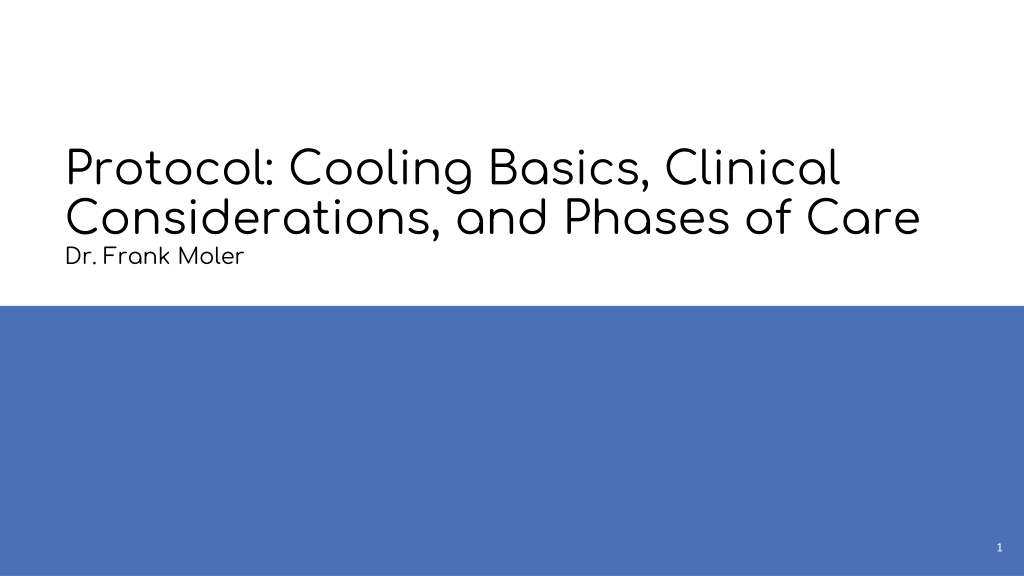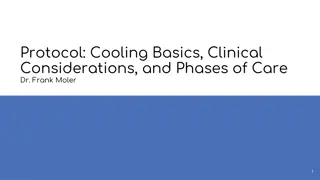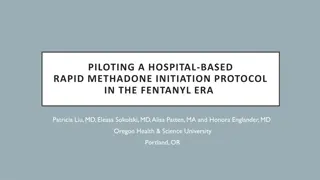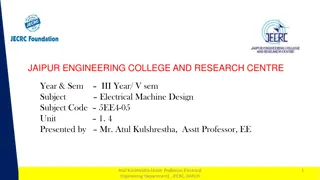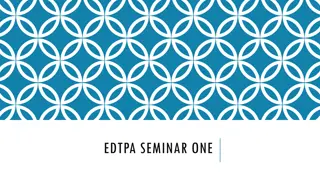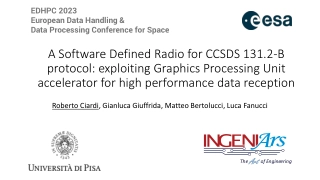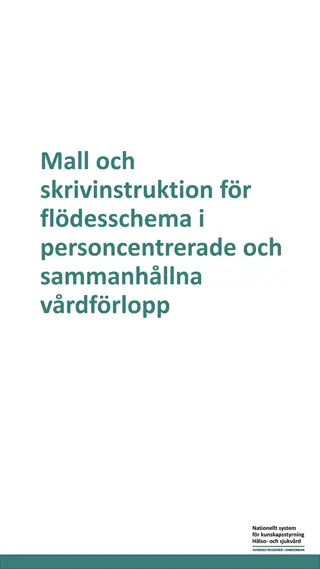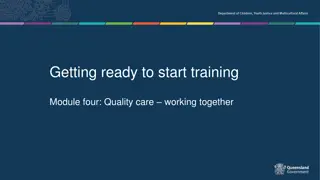Protocol: Cooling Basics, Clinical Considerations, and Phases of Care
The essentials of cooling protocols and clinical considerations, focusing on temperature management, thermoregulation basics, effects of hypothermia/cooling, central temperature measurement, and factors influencing target temperature. It emphasizes the importance of safe monitoring and application of cooling techniques during the various phases of care. Key topics discussed include definitions, therapeutic normothermia, and normal thermoregulation processes.
Download Presentation
Please find below an Image/Link to download the presentation.
The content on the website is provided AS IS for your information and personal use only. It may not be sold, licensed, or shared on other websites without obtaining consent from the author. Download presentation by click this link. If you encounter any issues during the download, it is possible that the publisher has removed the file from their server.
Presentation Transcript
Protocol: Cooling Basics, Clinical Considerations, and Phases of Care Dr. Frank Moler 1
Overview This talk reviews basic temperature (temp) related information needed for P- ICECAP. There is much information to know. Key content is repeated. (Sorry, no Greatest Movies of All Time trivia breaks as in THAPCA). Periodic review will be required during the trial. The information presented will assist the research team in safe monitoring and application of cooling in our study subjects. Just in time reviews with the clinical teams will be optimal, especially for the Induction of cooling and the Rewarming phases of P-ICECAP. 2
Outline Definitions Thermoregulation - basics Physiologic and other clinical effects of hypothermia/cooling Central temperature measurement Factors impacting target temperature Cooling protocol through 120 hours Review/Checklist (extra) Cases (extra) 3
Polderman CCM 2009 5
Therapeutic Normothermia = Normothermia TTM 36.0-37.5 C (36.8) = Cooling TTM 32.0-34.0 C (33.0) Therapeutic Hypothermia *Concern for arrhythmias at temp < 30 C. Rewarm STAT to goal **Greatly increased risk of VF and other arrhythmias < 28 C. STAT rewarming required. Irwin and Rippe. Intensive Care Medicine, 4th ed, 1999 6
Thermoregulation Basics 101 7
Normal Thermoregulation Heat production Normal heat production from metabolic processes in liver, viscera, and muscle During exercise or shivering, muscle primary source of heat generation, may be very large Heat elimination Radiation = heat from skin to object without contact (NA) Convection = airflow across skin (minor P-ICECAP) Conduction = skin to object in contact (#1 in P-ICECAP) Evaporation = sweating (NA in P-ICECAP) - - - - - - 8
Normal Thermoregulation Hypothalamus regulates body T - Afferent inputs to hypothalamus Skin*, abdomen, thorax, spinal cord, brain - Hypothalamus processes based on its setpoint - Central temp below hypothalamic setpoint results in efferent responses Cutaneous vasoconstriction - impedes heat transfer through skin Shivering - generates heat (muscles) 9
Thermoregulation Pediatrics Smaller infants / children Larger SA/volume compared to adults Reduced shivering response < 1 yr Easier/shorter time to induce hypothermia (cooling) and temp control in very young Shivering decreases at approximately 33.5 C P-ICECAP goal 33.0 C in hypothermia (cooled) groups 11
Normal thermoregulation Normothermia Phase If hypothalamic set point is elevated (e.g., fever at 39 C) relative to a goal temp 36.8 C, one will see similar physiologic responses as Therapeutic Hypothermia (cooling) induction phase Vasoconstriction Shivering Common etiologies of increased set point (fever) Post-cardiac arrest syndrome Infection Normal temp range is ~36.5-37.5 C during a day. Cooling devices sensitive to approx. 0.2 C from set point. They will attempt to warm and cool normal subjects! 12
List of Physiologic Effects Shivering Hypovolemia (during cooling and rewarming) CV including bradycardia Potassium Glucose Other chemistries (Mg, PO4, etc.) LFTs, amylase/lipase, lactate Plts/Coags WBC/Inflammation/Infection 1. 2. 3. 4. 5. 6. 7. 8. 9. 10. Drug metabolism 11. Metabolic rate 12. Blood gases 13. Skin Modified from: - Polderman, CCM 2009 - ILCOR, Circulation, 2008 14
1. Shivering Frequent, causes heat generation and rewarming Tx (REQUIRED) Suggested agents - Opioids (e.g., fentanyl) - Benzodiazepines (e.g., midazolam) and others - NMB (e.g., vecuronium) Shivering response decreases at ~ 33.5 C Shivering response less in young (< 1 yr) Will see shivering in both hypothermia (cooled) and normothermia phases, if hypothalamic set point is greater than goal temperature May or may not be visible 15
1. Shivering drugs to inhibit Benzodiazepines* (midazolam - example) - Sedative - Vasodilation (+/-) - Antiepileptic effects - Decrease shivering Opiods* (fentanyl - example) - Analgesia, sedation - Vasodilation (+/-) - Decrease shivering NMB* (vecuronium, rocuronium and others). Cis-Atracurium has temperature dependent metabolism, prolonged with cooling (Hofmann Reaction). Twitch monitoring with infusions. - Inhibits shivering, facilitates cooling and temperature control - Masks sedation level and seizures *ILCOR, Circulation 2008 drug classes recommended 16
Polderman CCM 2009 Induction of Hypothermia without sedation If hypothalamic set point normal at 37.0 C - Vasoconstriction - 36.5 C - Shivering - 35.5 C - HR - Metabolic rate (40-100%) - Stress response Undesirable in patients with neurologic and/or post hypoxic injury Increased risk of adverse cardiac events 17
Polderman CCM 2009 Induction of Hypothermia with sedation/analgesia Shivering HR Metabolic rate Stress response Improved neurologic outcome compared to no sedation/analgesia. Proper sedation & analgesia are important for successful use of cooling (Polderman 2009). 18
2. CV: Hypovolemia Hypovolemia common during the cooling Induction Phase - often due to cold diuresis (renal); - results in tachycardia and hypotension; - requires tx - Note: if patient cooled and HR not reduced, may be sign of hypovolemia Hypovolemia also common during Rewarming Phase - Vasodilation; may result in tachycardia and hypotension; requires tx 19
3. CV effects Cardiovascular (assuming pt deeply sedated and euvolemic) - BP (MAP), CVP, MV02 - HR - CO (due to HR), but improved O2supply/demand ratio Case series cooling used for low cardiac output states (LCOS) Used for JET post op ped cardiac patients 20
3. CV effects ECG changes - Bradycardia (? HR) common (? PR, ? QRS,? QT intervals) - No specific tx usually required for ? HR, if temp >30 C and otherwise stable Atropine ineffective If hypothermic without ? HR, consider hypovolemia or inadequate sedation as cause - Other arrhythmias uncommon if temp > 30 C! - Arrhythmias at temps < 30 C 28-30 C - ? (AF & VF) < 28 C - ? ? VF. STAT rewarming required if <30 C (MANUAL Mode required for Blanketrol-III) 21
4. Electrolytes (Potassium = K+) Close monitoring of K required post arrest due to AKI risk Electrolytes q 6 hr during cooling and rewarming phases and q 12 hr during other phases Induction Phase - serum K decreases Careful replacement as needed Rewarming Phase - serum K increases Slow rewarming results in less elevation in K If patient received insulin for hyperglycemia and extra K replacement given, this may result in greater K on rewarming be careful Consider removing K from IV fluids during rewarming; supplement prn only if needed 22
5. Hyperglycemia (GLU) Common post arrest due to stress response Relative insulin resistance with cooling Significance & optimal range for GLU unknown Neonatal, adult and THAPCA RCTs did not use tight control Often improves without tx in first 24 hr Important: if insulin for hyperglycemia used during cooling, will need more K+ replacement. This may lead to HYPERkalemia and HYPOglycemia on rewarming as insulin resistance resolves. Protocol suggests <200 mg/dl (range 80-200) acceptable consider reducing glucose in IV solutions, insulin only as needed for GLU > 200. Monitor q 6-12 hr. More often if insulin used. 23
6. Chemistries (other) Phosphate, Magnesium, Calcium - Each may decrease during cooling - Monitored at least daily - Replace if indicated 7. LFTs, Amylase/Lipase, Lactate Amylase, lipase, liver enzymes Lactate (up to 6 mmol/L) - Monitor at least daily - No tx generally required - Elevations also commonly associated with cardiac arrest 24
8. Hematology/Coagulation Platelets - Mildly reduced numbers common - May require tx [platelet transfusion] if level too low for clinical setting (e.g., chest tube bleeding). Mild abnormalities coagulation studies ~ 33 C - NOT seen when measured in lab (37 C) - Usually requires no tx [FFP transfusion] Clinical trials including THAPCA-IH did not describe increased bleeding with cooling. Monitor at least daily 25
9. Hematologic (Neutropenia)/Infection WBC (neutropenia) may occur Impaired inflammatory response with cooling Potentially higher risk of infection Out of hospital cardiac arrests commonly associated with VAP and/or BSI in adults THAPCA overall positive cultures 39-46% (lung, blood and urine). Drowning subgroup 43-67% IMPORTANT: Consider antibiotic prophylaxis in BOTH cooled & normothermia groups as fever will be masked in both. 26
10. Drug Metabolism Drug clearance often dependent on enzyme reactions Hypothermia is expected to be associated with slower drug clearance and potentially higher drug levels (opiates, benzos, NMBs, etc.). - Follow levels if available (i.e., phenobarb) - Titrate sedation drugs to effect - Consider cautious use of drugs that cause bradycardia (i.e., dexmedetomidine?) 27
11. Metabolic Rate Reduced with cooling (32-34 C) ~8-10% per degree C Caloric requirements decrease during cooling ~30-40% Do not over feed 28
12. Blood Gases PaO2and PaCO2solubility differs by temp Controversial if correction should be done P-ICECAP, like THAPCA, will not temp correct ABGs Report at standard body temp 37.0 C A rough estimate of temp correction to 33 C ~ PaCO2= 2 torr/ C = ~ 8 torr ~ PaO2= 5 torr/ C = ~20 torr 29
13. Skin Closely observe skin and provide good nursing care during 120 hrs. of temperature management. Cooling not associated with skin break down in Neonatal cooling trials up to 72 hr. or THAPCA 48 hr. Larger, malnourished, immobile patients may be at greater risk 30
Central Temperature Measurement 31
Temperature Measurement Central temperature measurement required to estimate blood temp (Gold Standard) Delay in a central site to reflect blood temp in real time is associated with overshoot of cooling - Ideal site = accurate, short time lag Dual central temp measurements required for all patients (Primary to cooling device; Secondary to bedside monitor or cooling device). Exception - ECMO cases 1 central temp (or venous circuit blood) only required 32
Esophageal (Preferred primary site attached to the cooling devise (Arctic Sun, Blanketrol, other). Used as sole temp site in NICHD neonatal trials - Accuracy: High level - Time lag: Shortest = 5 min (2-10 min) - Insertion: easy, but need to verify position - IMPORTANT: Correct placement in lower 1/3 of esophagus is critical If in stomach, temp may measure low by 1-3 C If tube feeds (gastric) and reflux, may make measurement inaccurate Vented G-tube accuracy? 33
Rectal (secondary probe to monitor) - Accuracy: Moderate level - Time lag: Moderate = 15 min (10-40 min) - Insertion: Easy - Dislocation: Common. Monitor for it. Bladder (secondary probe to monitor) - Accuracy: Moderate level - Time lag: Moderate = 20 min (10-60 min) - Insertion: Easy - Dislocation: Uncommon. Low urine output may result in less accurate measurements - Not available for smallest infants *If Esophageal probe is not used as primary probe, then Rectal or Bladder will need to be selected. 34
Skin sites (skin, axillary, etc) - Accuracy: Inaccurate not a central temperature. Do not use. - Time lag: Moderate = 20 min (10-60 min) - Insertion: Easy - Dislocation: Uncommon Tympanic membrane (better than Skin) - Accuracy: Moderate, may be inaccurate - Time lag: Moderate = 10 min (10-20 min) - Insertion: Easy; quick - Dislocation: NA - Other: not continuously measured 35
Central Temp Differences Two central temps for safety If within 1 C - acceptable If consistently > 1 C, escalating action required - Notify the site PI - Verify probe placement (esophageal, rectal) - Verify YSI 400 compatible probes used - Stomach feeds/GE reflux (esophageal probe) - Low urine output (temp sensing Foley) - Determine which probe is most accurate to be Primary connected to the cooling device. 36
Factors influencing ability to maintain goal temperature 37
1. Patient factors Patient factors impeding cooling Size (larger, obesity) Shivering (commonly subclinical) - Sedation/analgesia/NMB (Inadequate) - Sepsis/Infection Seizures Extremely reduced CO/poor skin perfusion 38
2. Skin surface area for cooling Surface area for contact (Conduction) - 2 vs. 1 blankets (i.e., anterior/posterior vs. posterior) - Positioning of patient (i.e., side vs. back) - Probably less of issue with Arctic Sun pads Extraneous materials between patient and blankets/pads (Maxi-Therm Lite or Arctic Sun pads) - Minimize, none required, no sheets 39
3. Cooling Devices Know how to use your cooling device per the manufacturer's recommendations! Also, know important limitations of your device Most common devices used in P-ICECAP are: 1) Blanketrol-III: Gentherm (formerly CSZ) has improved educational materials and videos on website. https://www.gentherm.com/en/medical/hyper-hypothermia/blanketrol-3 2) Arctic Sun: BD outstanding hands-on customer service 3) Other (Criticool, etc.) Unlike THAPCA, we are not instructing on the use of any device. Examples used are for discussion purposes only. 40
3. Cooling Equipment: Example of modes Blanketrol-III AUTO CONTROL Mode - Warms or cools water to max range of 4 - 42 C when patient s central temp +/- 0.2 C from Blanketrol Set Point temp. - For large patients. GRADIENT VARIABLE MODE (Plus SMART MODE) - Warms or cools water to narrower range; dampens temp fluctuation compared to AUTO CONTROL Mode. - For smaller patient sizes. - Example (assume patient 34 C and set point 33 C ) AUTO CONTROL: Gradient Variable 20 C: 14 - 42 C Gradient Variable 10 C: 24 - 42 C. For smallest patients Defer to manufacturer/vendor for optimal set up and use 4 - 42 C For large patients 41
Temperature Tracings (from Primary Probe) Not in range AUTO Mode NMB, Sedation - - In range GRADIENT VARIABLE Mode 10 C NMB, sedation - - 42
3. Blanketrol and SMART MODE GRADIENT VARIABLE with SMART MODE Blanketrol-III A modification to the GRADIENT VARIABLE MODE. SMART MODE will decrease the water temperature set in GRADIENT VARIABLE MODE by 5 C if the goal temperature is not achieved within 30 minutes. It reverts to the GRADIENT VARIABLE MODE once the target temperature goal is achieved. This mode is suggested to be used by the manufacturer (Gentherm). See User Guide and Inservice videos updated since THAPCA. https://www.gentherm.com/en/medical/hyper-hypothermia/blanketrol-3 43
3. Blanketrol-III Manual Mode - Blanketrol-III Not normally used except for emergencies IMPORTANT: Key fact to know for Blanketrol! Manual mode is required if patient's (pt) tempis ever 30 C None of the other Blanketrol Modes function if patient temp is 30 C Suggest setting the Manual Mode to highest (warmest) setting (42 C) briefly until the pt temp is 33 C. Then use Auto Control of a Gradient Variable SMART Mode depending on patient size *IMPORTANT - In the Manual Mode, the bedside nurse must continuously observe the pt s temp. The pt is 100% dependent on careful temp titration by nurse. 44
Protocol Overview Through 120 Hours 45
Overview from 37,000 feet Example University of Michigan PICU PICU fellow is contacted re: an OHCA from outside ED or our UM ED. The research team on call is immediately notified of a pending OHCA admit. Research team discusses with clinical team the case summary, arrival time, and approach for consent Order for nursing to get cooling equipment to bedside: - Blanketrol-III, two Maxi-Therm Lite cooling blankets (Ped or Adult), 2 hoses, 2 temperature probes and temp sensing Foley of correct size On pt arrival, clinical team stabilizes, places CVC, art line. Cooling device started as soon as it is safe to do so. Clinical team initiates their usual TTM target between 33-37 C before consent. 46
Overview from 37,000 feet Research team gets informed consent and randomizes to 1 of 3 cooling durations (24, 48 or 72 hrs) for first 150 pts ( burn-in phase). Subject enrollment = time randomized to a study cooling duration. TTM 33 C will be set as the target temp no later than 15 min following randomization. - If it was started prior to randomization, then the start time for cooling will be when a target 32-34 C range was set. Protocol goal is to achieve a temp range of 32-34 C no later than 2 hr. after randomization. - Sedation and NMB for induction phase results in fastest time to goal 47
Overview from 37,000 feet Cooling duration is equal to the combined time of the Induction plus Maintenance phases. After the cooling duration is completed, slow rewarming over at least 16 hrs. is done. Then normothermia 36.8 C for rest of 120 hr. 48
Durations of Cooling in P-ICECAP Patient Timeline 0 - 120 Hours 49
Cooling Duration Different than how it was defined in THAPCA. Cooling duration - Induction Phase + Maintenance Phase combined times. Starts when cooling device is set at target of 33 C [32-34 C]. Ends when planned rewarming starts. Induction phase starts when cooling device is set to the target temperature of 33 C post randomization (or 32-34 C range pre-randomization) and ends when the range of 32-34 C is achieved. Goal < 2 hrs. Maintenance phase the remaining time to complete the assigned cooling duration. Ends at the start of rewarming. For the first 150 patients in P-ICECAP, the cooling durations will be 24, 48 or 72 hours only. (All patients cooled). Other cooling durations (0 to 96 hrs.) will be added in Year 3. DCC will provide sites with the exact time to begin rewarming. 50
